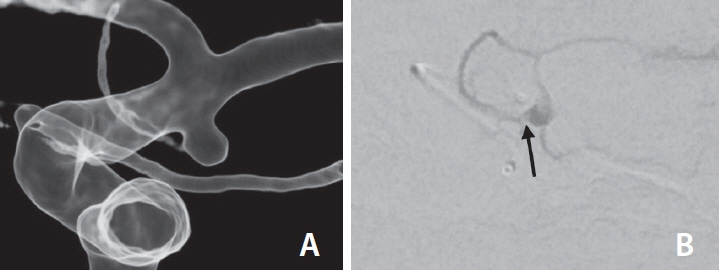Neurointervention.
2024 Nov;19(3):162-168. 10.5469/neuroint.2024.00353.
Technical Approaches for Coil Embolization of Unruptured Small Anterior Choroidal Artery Aneurysms: A Focus on Anatomical Flow Preservation of the Anterior Choroidal Artery
- Affiliations
-
- 1Department of Neurointervention, GangNam St. Peter’s Hospital, Seoul, Korea
- KMID: 2560220
- DOI: http://doi.org/10.5469/neuroint.2024.00353
Abstract
- The anterior choroidal artery (AChA) supplies the corticospinal tract related to the motor function of the upper and lower limbs. Aneurysms arising at the AChA are not common and exhibit various patterns of involvement of the AChA. Hence, managing an AChA aneurysm poses a high risk of neurological deficits. We report technical issues related to the outcome of coil embolization for unruptured AChA aneurysms. We obtained Institutional Review Board approval for this study. In the past 2 years, 18 consecutive patients (6 males and 12 females, aged 32–68) with unruptured AChA aneurysms were treated using embolization. We present technical details, pre- and post-procedural patient statuses, angiographic outcomes, and recurrence during a mean follow-up period of 12 months (range 3–25). The patients with AChA (n=18) underwent stent-assisted coiling (n=14), coiling (n=2), or stenting only (n=2). The technical strategy for aneurysm embolization included a low-lying approach into the aneurysm, stent-strut abutting (protecting) coil framing to block inflow and avoid compromising AChA flow, and direct intra-aneurysmal angiography via a microcatheter. Angiographic results showed complete occlusion (n=11), neck remnant (n=5), and sac remnant (n=2). During the follow-up, there were 2 recurrences, and 1 of them required a re-procedure. All patients showed no change in clinical status (modified Rankin scale score=0) and did not experience any ischemic or hemorrhagic events during the follow-up period. AChA aneurysms can be managed through embolization using various techniques. Such technical concepts may enhance the safety and improve the outcomes of AChA aneurysm embolization.
Figure
Reference
-
1. Kim BM, Kim DI, Shin YS, Chung EC, Kim DJ, Suh SH, et al. Clinical outcome and ischemic complication after treatment of anterior choroidal artery aneurysm: comparison between surgical clipping and endovascular coiling. AJNR Am J Neuroradiol. 2008; 29:286–290.2. Hendricks BK, Spetzler RF. Surgical challenges associated with anterior choroidal artery aneurysm clipping: 2-dimensional operative video. Oper Neurosurg (Hagerstown). 2020; 19:E289.3. Eun C, Lee SJ, Park JC, Ahn JS, Kwun BD, Park W. Efficacy of intraoperative neuromonitoring (IONM) and intraoperative indocyanine green videoangiography (ICG-VA) during unruptured anterior choroidal artery aneurysm clipping surgery. J Cerebrovasc Endovasc Neurosurg. 2023; 25:150–159.4. Al Fauzi A, Rahmatullah MI, Suroto NS, Utomo B, Fahmi A, Bajamal AH, et al. Comparison of outcomes between clipping and endovascular coiling in anterior choroidal artery aneurysm: a systematic review. Neurosurg Rev. 2023; 46:276.5. Sheen JJ, Suh DC. Low-angled microcatheter approach for coil embolization of the anterior choroidal artery aneurysm. Neuroradiology. 2017; 59:1053–1056.6. Suh DC, Choi YH, Park SI, Yun S, Jeong SY, Jeong S, et al. Outpatient day-care management of unruptured intracranial aneurysm: a retrospective cohort study. Korean J Radiol. 2022; 23:828–834.7. Song Y, Kwon B, Al-Abdulwahhab AH, Kurniawan RG, Suh DC. Microcatheter stabilization technique using partially inflated balloon for coil embolization of paraclinoid aneurysms. Neurointervention. 2021; 16:132–140.8. Kurniawan RG, Song Y, Kwon B, Ahn Y, Suh DC. Tailored antiplatelet agent medication in clopidogrel hyporesponsive patients before stent-assisted coiling: single-center experience. Neuroradiology. 2020; 62:1709–1715.9. Lee D, Song Y, Shin JH, Suh DC. Low-dose prasugrel in patients with resistance to clopidogrel for the treatment of cerebral aneurysms: follow-up of over 6 months. Neurointervention. 2019; 14:68–70.10. Jia ZY, Song YS, Sheen JJ, Kim JG, Lee CW, Suh DC. Loop microcatheter technique for coil embolization of paraclinoid aneurysms. Acta Neurochir (Wien). 2018; 160:1755–1760.11. Song Y, Choe J, Liu H, Park KJ, Yu H, Lim OK, et al. Virtual stenting of intracranial aneurysms: application of hemodynamic modification analysis. Acta Radiol. 2016; 57:992–997.12. Park W, Song Y, Park KJ, Koo HW, Yang K, Suh DC. Hemodynamic characteristics regarding recanalization of completely coiled aneurysms: computational fluid dynamic analysis using virtual models comparison. Neurointervention. 2016; 11:30–36.13. Liu H, Choe J, Jung SC, Song Y, Yang KH, Park KJ, et al. Does a low-wall coverage stent have a flow diverting effect in small aneurysms? Neurointervention. 2015; 10:89–93.14. André A, Boch AL, Di Maria F, Nouet A, Sourour N, Clémenceau S, et al. Complication risk factors in anterior choroidal artery aneurysm treatment. Clin Neuroradiol. 2018; 28:345–356.15. Wolman DN, Moraff AM, Heit JJ. Anatomy of the intracranial arteries: the internal carotid artery. Neuroimaging Clin N Am. 2022; 32:603–615.16. Duan Y, Qin X, An Q, Liu Y, Li J, Chen G. A new classification of anterior choroidal artery aneurysms and its clinical application. Front Aging Neurosci. 2021; 13:596829.17. Park J, Kim JS. Infundibular widening of angiographically invisible duplicate anterior choroidal artery mimicking typical anterior choroidal artery aneurysm. J Korean Neurosurg Soc. 2023; 66:105–110.18. Irie T, Yoshitani K, Ohnishi Y, Shinzawa M, Miura N, Kusaka Y, et al. The efficacy of motor-evoked potentials on cerebral aneurysm surgery and new-onset postoperative motor deficits. J Neurosurg Anesthesiol. 2010; 22:247–251.19. Szelényi A, Langer D, Kothbauer K, De Camargo AB, Flamm ES, Deletis V. Monitoring of muscle motor evoked potentials during cerebral aneurysm surgery: intraoperative changes and postoperative outcome. J Neurosurg. 2006; 105:675–681.
- Full Text Links
- Actions
-
Cited
- CITED
-
- Close
- Share
- Similar articles
-
- Treatment results of anterior choroidal artery aneurysms treated mostly with coil embolization: A single-center experience
- Transposition of Anterior Choroidal Artery and Posterior Communicating Artery Origin
- Anterior Choroidal Artery Aneurysms: Influence of Regional Microsurgical Anatomy on Safety of Endovascular Treatment
- Clinical Experiences of Anterior Choroidal Artery Aneurysm
- Coil embolization and recurrence of ruptured aneurysm originating from hyperplastic anterior choroidal artery





